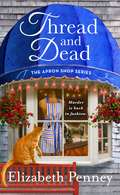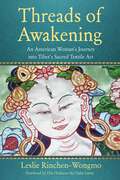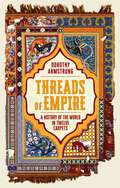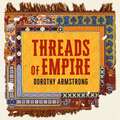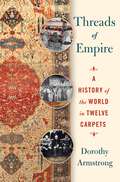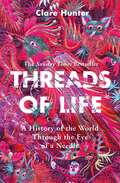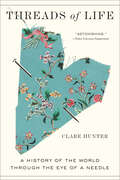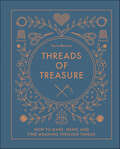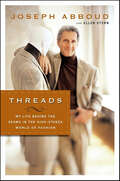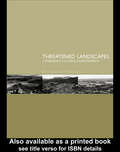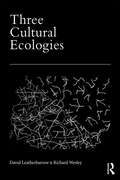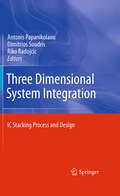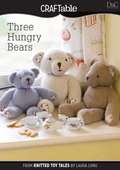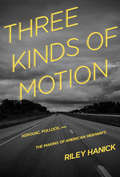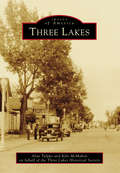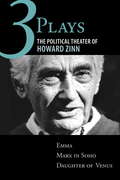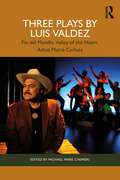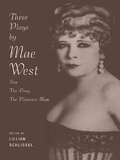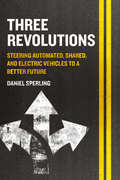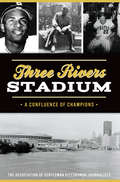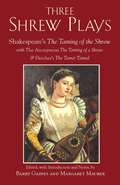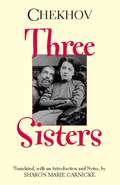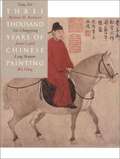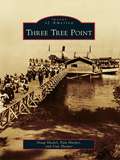- Table View
- List View
Thread and Dead: The Apron Shop Series (Apron Shop Series #2)
by Elizabeth PenneyTragedy strikes in Thread and Dead, the second book in Elizabeth Penney's cozy mystery series—and now everyone in Blueberry Cove, Maine, is on pins and needles. . .Iris Buckley is busier than ever this July, with the town’s annual Lobster Festival fast approaching. In just a matter of days her apron shop Ruffles & Bows, will be jam-packed with tourists eager to lay eyes on its world-class collection of aprons and linens—and Iris’s inventory is running low. Then, just when all hope seems lost, Iris gets a call from Eleanor Brady, a wealthy, reclusive spinster who just happens to have trunks full of vintage fabrics. Would Iris like to come down to Eleanor’s cottage estate Shorehaven and have a look? Before long Iris is on the scene—and on the case. Turns out that Eleanor has rented Shorehaven to the handsome, charismatic environmentalist Dr. Lukas de Wilde and his flock of students. What begins as an apron-scouting endeavor soon morphs into a full-blown murder investigation when Dr. de Wilde’s beautiful young teaching assistant turns up dead. Now it’s up to Iris—along with her partner-in-love-and-crime Ian Stewart—to unravel the mystery before the Blueberry Cove killer strikes again.Praise for The Apron Shop series“Quirky-meets-fun.”—Woman's World on Hems & Homicide “Penney knows the recipe for delivering just what cozy readers are looking for.” —Reviewing the Evidence
Threads of Awakening: An American Woman's Journey into Tibet's Sacred Textile Art
by Leslie Rinchen-WongmoWhat if you set out to travel the world and got sidetracked in a Himalayan sewing workshop? What if that sidetrack turned out to be your life’s path—your way home? Part art book, part memoir, part spiritual travelogue, Threads of Awakening is a delightful and inspiring blend of adventure and introspection. Leslie Rinchen-Wongmo shares her experience as a California woman traveling to the seat of the Tibetan government-in-exile in India to manage an economic development fund, only to wind up sewing pictures of Buddha instead. Through her remarkable journey, she discovered that a path is made by walking it—and that some of the best paths are made by walking off course. For more than 500 years, Tibetans have been creating sacred images from pieces of silk. Much rarer than paintings and sculptures, these stitched fabric thangkas are among Tibet's finest artworks. Leslie studied this little-known textile art with two of its brightest living masters and let herself discover where curiosity and devotion can lead. In this book, she reveals the unique stitches of an ancient needlework tradition, introduces the Buddhist deities it depicts, and shares insights into the compassion, interdependence, and possibility they embody. Includes 49 full-color photos and a foreword by the Dalai Lama.
Threads of Empire: A History of the World in Twelve Carpets
by Dorothy ArmstrongA spellbinding look at the history of the world through the stories of twelve carpetsBeautiful, sensuous, and enigmatic, great carpets follow power. Emperors, shahs, sultans and samurai crave them as symbols of earthly domination. Shamans and priests desire them to evoke the spiritual realm. The world's 1% hunger after them as displays of extreme status. And yet these seductive objects are made by poor and illiterate weavers, using the most basic materials and crafts; hedgerow plants for dyes, fibres from domestic animals, and the millennia-old skills of interweaving warps, wefts and knots.In Threads of Empire, Dorothy Armstrong tells the histories of some of the world's most fascinating carpets, exploring how these textiles came into being then were transformed as they moved across geography and time in the slipstream of the great. She shows why the world's powerful were drawn to them, but also asks what was happening in the weavers' lives, and how they were affected by events in the world outside their tent, village or workshop. In its wide-ranging examination of these dazzling objects, from the 5th century BCE contents of the tombs of Scythian chieftains, to the carpets under the boots of Stalin, Roosevelt and Churchill at the 1945 Yalta Peace Conference, Threads of Empire uncovers a new, hitherto hidden past right beneath our feet.
Threads of Empire: A History of the World in Twelve Carpets
by Dorothy ArmstrongA spellbinding look at the history of the world through the stories of twelve carpetsBeautiful, sensuous, and enigmatic, great carpets follow power. Emperors, shahs, sultans and samurai crave them as symbols of earthly domination. Shamans and priests desire them to evoke the spiritual realm. The world's 1% hunger after them as displays of extreme status. And yet these seductive objects are made by poor and illiterate weavers, using the most basic materials and crafts; hedgerow plants for dyes, fibres from domestic animals, and the millennia-old skills of interweaving warps, wefts and knots.In Threads of Empire, Dorothy Armstrong tells the histories of some of the world's most fascinating carpets, exploring how these textiles came into being then were transformed as they moved across geography and time in the slipstream of the great. She shows why the world's powerful were drawn to them, but also asks what was happening in the weavers' lives, and how they were affected by events in the world outside their tent, village or workshop. In its wide-ranging examination of these dazzling objects, from the 5th century BCE contents of the tombs of Scythian chieftains, to the carpets under the boots of Stalin, Roosevelt and Churchill at the 1945 Yalta Peace Conference, Threads of Empire uncovers a new, hitherto hidden past right beneath our feet.
Threads of Empire: A History of the World in Twelve Carpets
by Dorothy ArmstrongCarpet specialist Dorothy Armstrong tells the stories surrounding twelve of the world’s most fascinating carpets.Dorothy Armstrong’s Threads of Empire is a spellbinding look at the history of the world through the stories of twelve carpets. Beautiful, sensuous, and enigmatic, great carpets follow power. Emperors, shahs, sultans and samurai crave them as symbols of earthly domination. Shamans and priests desire them to evoke the spiritual realm. The world’s 1% hunger after them as displays of extreme status. And yet these seductive objects are made by poor and illiterate weavers, using the most basic materials and crafts; hedgerow plants for dyes, fibers from domestic animals, and the millennia-old skills of interweaving warps, wefts and knots.In Threads of Empire, Armstrong tells the histories of some of the world’s most fascinating carpets, exploring how these textiles came into being then were transformed as they moved across geography and time in the slipstream of the great. She shows why the world’s powerful were drawn to them, but also asks what was happening in the weavers’ lives, and how they were affected by events in the world outside their tent, village or workshop. In its wide-ranging examination of these dazzling objects, from the 5th century BCE contents of the tombs of Scythian chieftains, to the carpets under the boots of Stalin, Roosevelt and Churchill at the 1945 Yalta Peace Conference, Threads of Empire uncovers a new, hitherto hidden past right beneath our feet.
Threads of Life: A History of the World Through the Eye of a Needle
by Clare Hunter**SUNDAY TIMES BESTSELLER** **RADIO 4 BOOK OF THE WEEK** **WATERSTONES SCOTTISH BOOK OF THE MONTH**'An astonishing feat'Christina Patterson, Sunday Times'An inspiring and moving sideways look at history'Eithne Farry, Sunday Express An eloquent blend of history and memoir, Threads of Life is an evocative and moving book about the need we all have to tell our story.From political propaganda in medieval France to secret treason in Tudor England, from the mothers of the desaparecidos in Argentina to First World War soldiers with PTSD, from a POW camp in Singapore to a family attic in Scotland, Threads of Life is a global chronicle of identity, protest, memory and politics. Banner-maker, community textile artist and textile curator Clare Hunter chronicles the stories of the men and women, over centuries and across continents, who have used the language of sewing to make their voices heard, even in the most desperate of circumstances.'A beautifully considered book... Clare Hunter has managed to mix the personal with the political with moving results.' TRACY CHEVALIER
Threads of Life: A History of the World Through the Eye of a Needle
by Clare Hunter**SUNDAY TIMES BESTSELLER** **RADIO 4 BOOK OF THE WEEK** **WATERSTONES SCOTTISH BOOK OF THE MONTH**'An astonishing feat'Christina Patterson, Sunday Times'An inspiring and moving sideways look at history'Eithne Farry, Sunday ExpressAn eloquent blend of history and memoir, Threads of Life is an evocative and moving book about the need we all have to tell our story.From political propaganda in medieval France to secret treason in Tudor England, from the mothers of the desaparecidos in Argentina to First World War soldiers with PTSD, from a POW camp in Singapore to a family attic in Scotland, Threads of Life is a global chronicle of identity, protest, memory and politics. Banner-maker, community textile artist and textile curator Clare Hunter chronicles the stories of the men and women, over centuries and across continents, who have used the language of sewing to make their voices heard, even in the most desperate of circumstances.'A beautifully considered book... Clare Hunter has managed to mix the personal with the political with moving results.' TRACY CHEVALIER
Threads of Life: A History of the World Through the Eye of a Needle
by Clare HunterThis globe-spanning history of sewing and embroidery, culture and protest, is “an astonishing feat . . . richly textured and moving” (The Sunday Times, UK). In 1970s Argentina, mothers marched in headscarves embroidered with the names of their “disappeared” children. In Tudor, England, when Mary, Queen of Scots, was under house arrest, her needlework carried her messages to the outside world. From the political propaganda of the Bayeux Tapestry, World War I soldiers coping with PTSD, and the maps sewn by schoolgirls in the New World, to the AIDS quilt, Hmong story clothes, and pink pussyhats, women and men have used the language of sewing to make their voices heard, even in the most desperate of circumstances. Threads of Life is a chronicle of identity, memory, power, and politics told through the stories of needlework. Clare Hunter, master of the craft, threads her own narrative as she takes us over centuries and across continents—from medieval France to contemporary Mexico and the United States, and from a POW camp in Singapore to a family attic in Scotland—to celebrate the universal beauty and power of sewing.
Threads of Treasure: How to Make, Mend, and Find Meaning through Thread
by Sara BarnesThis title will appeal to the trending needlework community. It also will capitalize on ecology and environmental trends. We are planning to create an innovative box set with a kit to allow engagement with the book.
Threads: My Life Behind the Seams in the High-Stakes World of Fashion
by Ellen Stern Joseph AbboudDesigners are great white sharks, and we roam the waters ourselves. We often pretend to like and admire each other, but sometimes we don't even bother to fake it. The fashion industry is as hardworking, incestuous, and political as any other, and it's virtually impossible, given the size of designers' egos, to sincerely wish someone else well, because behind every false tribute is 'It should have been me.'So writes Joseph Abboud, who fell in love with style at five. There in the dark of the movie house, he wasn't just some Lebanese kid with a babysitter. He was the hero, in tweeds and pocket squares. That's where he learned that clothes represented a better life—a life he wanted, and would grab, for himself. From his blue-collar childhood in Boston's South End to his spread-collar success as one of America's top designers, he has forged a remarkable path through the unglamorous business of making people look glamorous.He transformed American menswear by replacing the traditional stiff-shouldered silhouette with a grown-up European sensuality. He was the first designer to win the coveted CFDA award as Best Menswear Designer two years in a row and the first designer to throw out the opening pitch at Fenway Park. He's been jilted by Naomi Campbell (who didn't show up on the runway for his first women's fashion show) and questioned by the FBI (who did show up in his office right after September 11 because he fit the profile). He's soared and sunk more than a few times—and lived to tell the tales.Threads is his off-the-record take on fashion, from the inside out. With breezy irreverence, he looks at guys and taste, divas and deviousness, fabric and texture, and all those ties. He takes us to the luxe bastion of Louis Boston, where he came of age and learned the trade, and to the seductive domain of Polo Ralph Lauren, where he became associate director of menswear design. He reveals the mystique of department-store politics, what's what at the sample sale, and who copies whom. He explains the process of making great clothes, from conception and sketch to manufacturing and marketing.Whether he's traveling by daredevil horse, plunging plane, Paris Métro, or cross-country limo, Abboud is an illuminating guide to a complex world.
Threatened Landscapes: Conserving Cultural Environments
by Bryn Green Willem VosFew, if any, environments are free of human intervention. Often this generates ecosystems which are rich in biodiversity, historical interest, recreational opportunity and scenic beauty just as worthy of conservation as the more natural ecosystems on which protection programmes have been almost exclusively focussed.These 'cultural landscapes', ranging from the farm and forest lands of Europe and Eastern North America, through to the pasture lands and savannas of the Middle East and Africa to the paddylands of the Pacific Rim, are usually the product of relatively low-level, sustainable exploitation of the environment over long periods of time. Many have survived for centuries, if not millennia, but now urban expansion, depopulation of rural areas and, most damagingly, the intensification of agricultural and sylvicultural practices, are everywhere leading to a loss of their cherished biodiversity and amenity. Whilst past changes have mostly added to the valued characteristics of these landscapes, modern farming and forestry are creating sterile monocultures on the better land whilst marginal lands are being abandoned.This book documents these changes, illustrates them through detailed case studies of a representative selection of threatened landscapes, analyses their underlying causes and explores ways by which they can continue to be maintained, or new landscapes created which maintain their desired characteristics.
Three Cultural Ecologies
by David Leatherbarrow Richard WesleyThree Cultural Ecologies reverses common conceptions of modern architecture. It reveals how selected works of two modern architects, Le Corbusier and Frank Lloyd Wright, embraced environmental and cultural conditions as reciprocal and complementary. A basic premise of this book’s arguments is that cultural patterns cannot be adequately conceptualized in the terms that typically define ecology today. Instead, studies based on the natural sciences must be complemented by descriptions and interpretations of historical narratives, cultural norms, and individual expressions. Previously unpublished images and new interpretations will allow readers to rediscover works they thought they knew; Villa Savoye, Taliesin, La Tourette, and Ocatilla; as well as projects that are less well known: by Wright, the House on the Mesa and the City Residential Plan, and by Le Corbusier, the Immeuble-villas and Ilôt Insalubre projects. More broadly, this study of cultural ecology at three scales – domestic, monastic, and urban – reconsiders the history of modern architecture. The conditions brought about by societal and technological modernization and confronted by modern architecture have not disappeared in our time, but have intensified, making the task of imagining how some measure of equilibrium between culture and ecology might be achieved even more pressing.
Three Dimensional System Integration
by Antonis Papanikolaou Riko Radojcic Dimitrios SoudrisThree-dimensional (3D) integrated circuit (IC) stacking is the next big step in electronic system integration. It enables packing more functionality, as well as integration of heterogeneous materials, devices, and signals, in the same space (volume). This results in consumer electronics (e.g., mobile, handheld devices) which can run more powerful applications, such as full-length movies and 3D games, with longer battery life. This technology is so promising that it is expected to be a mainstream technology a few years from now, less than 10-15 years from its original conception. To achieve this type of end product, changes in the entire manufacturing and design process of electronic systems are taking place. This book provides readers with an accessible tutorial on a broad range of topics essential to the non-expert in 3D System Integration. It is an invaluable resource for anybody in need of an overview of the 3D manufacturing and design chain.
Three Hungry Bears
by Laura LongTeddy bears love having breakfast parties, and the more bears you knit, the bigger the party will be! Knit these bears in the softest alpaca yarn you can find. Whether you’re making the bears for small or big children, the luxurious feel of the yarn will offer warmth and comfort with every cuddle.
Three Kinds of Motion: Kerouac, Pollock, and the Making of American Highways
by Riley Hanick"Like a great conversationalist, Hanick paints a generous canvas, and I rode the length of this powerful book much like I first experienced the American interstate: songs on the stereo, windows down, and the bittersweet sense that youth is fleeting. Three Kinds of Motion holds open a wild and beautiful journey, not to be missed."--Thalia FieldIn 1943, Peggy Guggenheim commissioned a mural from Jackson Pollock to hang in the entryway of her Manhattan townhouse. It was the largest Pollock canvas she would ever own, and four years later she gave it to a small Midwestern institution with no place to put it. When the original scroll of On the Road goes on tour across the country, it lands at the same Iowa museum housing Peggy's Pollock, revitalizing Riley Hanick's adolescent fascination with the author. Alongside these two narrative threads, Hanick revisits Dwight D. Eisenhower's quest to build America's first interstate highway system. When catastrophic rains flood the Iowa highways with their famous allure and history of conquest, they also threaten the museum and its precious mural. In Three Kinds of Motion, his razor-sharp, funny, and intensely vulnerable book-length essay, Hanick moves deftly between his three subjects. He delivers a story with breathtaking ingenuity.Riley Hanick is an essayist, journalist, and translator. His work has received support from the Jentel and McKnight foundations and he has served as a writer-in-residence for the University of Iowa Museum of Art. He teaches at Murray State University.
Three Lakes
by Alan Tulppo Three Lakes Historical Society Kyle McmahonNestled in the heart of Wisconsin's renowned Northwoods and surrounded by the world's largest inland chain of lakes, Three Lakes has developed into a premier resort and vacation destination while maintaining its small-town character. The pristine woodland trails and picturesque lakeside views that residents and visitors of today are accustomed to were not always here. Three Lakes was founded as a supply station for the massive logging operations of the late 1800s and early 1900s. Much of the area was barren of standing timber by the end of the first decade of the 20th century. The community reinvented itself as an agricultural center and as a vacation destination that played host to such notable individuals as Amelia Earhart, Bob Hope, and Pres. Dwight D. Eisenhower. The community has always shown pride in its schools, churches, and local organizations.
Three Plays
by Howard ZinnWorld-renowned historian Howard Zinn has turned to drama to explore the legacy of Karl Marx and Emma Goldman and to delve into the intricacies of political and social conscience perhaps more deeply than traditional history permits. Three Plays brings together all this work, including the previously unpublished Daughter of Venus, along with a new introductory essay on political theater, and prefaces to each of the plays.From the Trade Paperback edition.
Three Plays by Luis Valdez: Fin del Mundo, Valley of the Heart, Adíos Mamá Carlota
by Luis ValdezCollecting together Fin del Mundo, Valley of the Heart, and Adíos Mamá Carlota, this book compiles the latest plays of Luis Valdez and explores how they stand to be considered masterpieces by the man who brought the world Zoot Suit and La Bamba.Luis Valdez has been described as the “last of the great American playwrights,” referring to a Golden Age of U.S. playwriting that began with Eugene O’Neill and included Tennessee Williams, Arthur Miller, and August Wilson. Like these other playwrights, Valdez’s impact on theatre needs to be measured on a global scale. The plays are psychologically deep, with powerful political messages woven into sophisticated plots and minutely drawn characters, all done with the characteristic rasquachi theatricality that made Valdez a household name. Fin del Mundo follows the protagonist through a maze-like urban afterlife that is by turns hilarious and deeply moving. In Valley of the Heart we witness a fictionalization of the true history of the relationship of Chicanos to Japanese-Americans during the horrific internments of World War II. Finally, in Adíos Mamá Carlota, we share the final moments of the former Empress of Mexico, teetering on the edge of madness, as she relives her extraordinary life and faces crippling guilt over her actions. Together, these plays represent a crowning achievement in the storied life of Luis Valdez. In this collection, each play is preceded by an introductory chapter by Jorge A. Huerta with analysis of the play.This collection is a vital and indispensable text for practitioners and students, as well as scholars of contemporary theatre, American, and Chicano performance.
Three Plays by Mae West: Sex, The Drag and Pleasure Man
by Lillian SchlisseMae West, wise-cracking vaudeville performer, was one of the most controversial figures of her era. Rarely, however, do people think of Mae West as a writer. In Three Plays By Mae West, Lillian Schlissel brings this underexplored part of West's career to the fore by offering for the first time in book form, three of the plays West wrote in the 1920s--Sex (1926), The Drag (1927) and Pleasure Man (1928). With an insightful introduction by Schlissel, this book offers a unique look into to the life and early career of this legendary stage and screen actress.
Three Revolutions: Steering Automated, Shared, And Electric Vehicles To A Better Future
by Daniel SperlingFor the first timein half a century, real transformative innovations are coming to our world of passenger transportation. The convergence of new shared mobility services with automated and electric vehicles promises to significantly reshape our lives and communities for the better—or for the worse.The dream scenario could bring huge public and private benefits, including more transportation choices, greater affordability and accessibility, and healthier, more livable cities, along with reduced greenhouse gas emissions. The nightmare scenario could bring more urban sprawl, energy use, greenhouse gas emissions, and unhealthy cities and individuals.In Three Revolutions, transportation expert Dan Sperling, along with seven other leaders in the field, share research-based insights on potential public benefits and impacts of the three transportation revolutions. They describe innovative ideas and partnerships, and explore the role government policy can play in steering the new transportation paradigm toward the public interest—toward our dream scenario of social equity, environmental sustainability, and urban livability.Many factors will influence these revolutions—including the willingness of travelers to share rides and eschew car ownership; continuing reductions in battery, fuel cell, and automation costs; and the adaptiveness of companies. But one of the most important factors is policy.Three Revolutions offers policy recommendations and provides insight and knowledge that could lead to wiser choices by all. With this book, Sperling and his collaborators hope to steer these revolutions toward the public interest and a better quality of life for everyone.
Three Rivers Stadium: A Confluence of Champions (Sports)
by The Association of Gentleman Pittsburgh JournalistErected on the city's Northside in 1970, Three Rivers Stadium was Pittsburgh's home of champions for three decades. It hosted the first-ever World Series game played at night as the Pirates would win their last two titles there. The Pitt-Penn State rivalry in college football was never more heated than under the bright lights of Three Rivers. The Steel Curtain era of the Steelers brought Super Bowl wins and elevated the stadium to become one of the most feared venues in all of professional sports. Locally referred to as the "House that Clemente Built," the stadium was the site of the beloved right fielder's 3,000th hit. Join local sportswriters as they recall the roaring crowds, rocking stands and greatest moments of Three Rivers Stadium.
Three Shrew Plays: Shakespeare's The Taming of the Shrew; with The Anonymous The Taming of a Shrew, and Fletcher's The Tamer Tamed
by Barry Gaines Margaret MaurerUnusual among Shakespeare's plays in that it drew theatrical responses from the outset, The Taming of the Shrew continues to inspire adaptations and interpretations that respond to its fascinating, if provocative, representation of a husband's dominance of his wife.This annotated collection of three early modern English plays allows readers to explore the relationship between Shakespeare's Shrew and two closely related plays of the same genre, the earlier of which, the anonymous The Taming of a Shrew (whether inspired by Shakespeare's play or vice-versa), once enjoyed a level of popularity that likely surpassed that of Shakespeare's play.The editors' Introduction brilliantly illuminates points of comparison between the three, their larger themes included, and convincingly argues that Shakespeare's Shrew is seen all the more vividly when the anonymous A Shrew and Fletcher's table-turning The Tamer Tamed are waiting in the wings.
Three Sisters
by Anton Chekhov Sharon Marie CarnickeFirst published in her Chekhov: Four Plays and Three Jokes, Sharon Marie Carnicke's eye-opening translation of Three Sisters appears in this edition with a new Introduction that expands upon her discussion in Four Plays & Three Jokes of Chekov's innovative dramaturgy--especially as seen in this subtle melodrama turned inside out.
Three Thousand Years of Chinese Painting
by Richard M. Barnhart James Cahill Wu HungFrom Neolithic painted petroglyphs, early paintings on silk, and landscapes by twelfth-century literati to the traditional handscrolls being produced today, Chinese painting has always had the power to enthrall. This magnificent book, written by a team of eminent international scholars, is the first to recount the history of Chinese painting over a span of some three thousand years. Drawing on museum collections, archives, and archaeological sites in China--including many resources never before available to Western scholars--as well as on collections in other countries, the authors present and analyze the very best examples of Chinese painting: more than 300 of them are reproduced here in color. Both accessible to the general reader and revelatory for the scholar, the book provides the most up-to-date and detailed history of China’s pictorial art available today. In this book the authors rewrite the history of Chinese art wherever it is found--in caves, temples, or museum collections. They begin by grounding the Western reader in Chinese traditions and practices, showing in essence how to look at a Chinese painting. They then shed light on such topics as the development of classical and narrative painting, the origins of the literati tradition, the flowering of landscape painting, and the ways the traditions of Chinese painting have been carried into the present day. The book, which concludes with a glossary of techniques and terms and a list of artists by dynasty, is an essential resource for all lovers of, or newcomers to, Chinese painting. Three Thousand Years of Chinese Painting is the inaugural volume in a new series, The Culture & Civilization of China, a joint publishing venture of Yale University Press and the American Council of Learned Societies with the China International Publishing Group in Beijing. The undertaking will ultimately result in the publication of more than seventy-five volumes on the visual arts, classical literature, language, and philosophy, as well as several comprehensive reference volumes.
Three Tree Point
by Doug Shadel Pam Harper Guy HarperThree Tree Point is a prominent peninsula on the eastern shore of Puget Sound about 14 miles south of Seattle. Its name came from three massive fir trees that stood on the north side of the point at the beginning of the 20th century. The area remained largely undeveloped until 1903 when the Three Tree Point Company began marketing the community as a place to build summer homes. Seattle's business elite built houses at the point to take advantage of the beach lifestyle for which it has become known. Over the years, Three Tree Point and its 2.5 miles of waterfront emerged as one of the Northwest's most unique residential communities. Its history is a diverse mixture of family life, unusual characters, Fourth of July celebrations, shipwrecks, fishing derbies, and storytelling.
